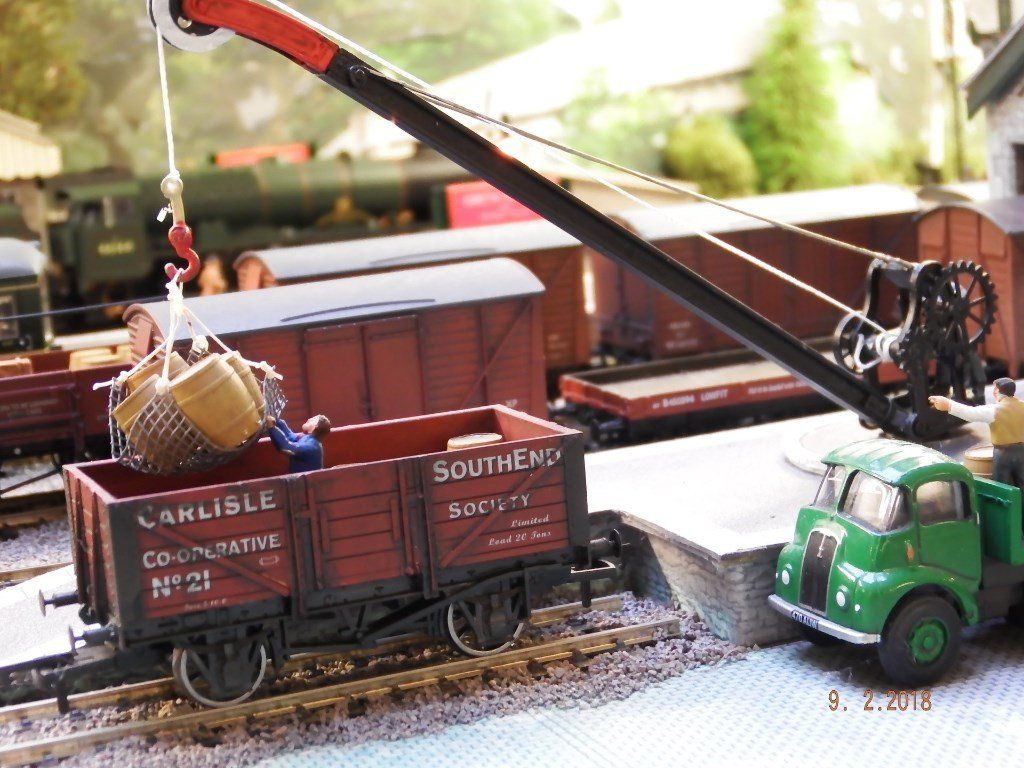
This is an 00 gauge, DCC operated model railway based upon the now vanished Cockermouth, Keswick & Penrith line, set around the late 1960's in British Railway days. Trains from London would split at Oxenholme on the West Coast Mainline (some carriages travelling on to Windermere) and at Penrith, where 2MT 2-4-0 steam locomotives piloted the remaining carriages to Keswick along the course of the River Greta in a spectacular gorge, and beyond to Cockermouth via the shores of Bassenthwaite Lake. It was one of the first lines to trial Diesel Multiple Units for local services. The line featured week-end specials and holiday traffic plus coal, stone and timber goods traffic. All the locos and rolling stock are models of the prototypes that actually ran on the line, plus some models of locomotives that were based at the London Midland Region depots of Carlisle or Barrow and could easily have been used on that line if circumstances required.
-
City skyline
Buttonabove: Bachmann 2MT leading a 'Lakes & Fells' Excursion with Blencathra in the background.
-
Birthday Sparks
Buttonabove: 4MT tank piloting the Lakes Express over a bow string bridge spanning the River Greta. The shingle is sieved from the real River Greta.
below, left & right: Greta Valley station and goods yard.
-
Fashion Magazine
Buttonabove: The regular Derby Lightweight DMU on the viaduct heading towards Greta Valley.
-
Blurred Lines
Buttonabove: Hornby Class 40 with the 'Budd Special' bringing visitors to the annual Keswick Convention.
below: Greta Valley station with Skiddaw mountain in the background
-
City skyline
Buttonabove: Thornthwaite level crossing
below: narrow guage railway crosses the bridge to climb towards Honister
-
Birthday Sparks
Buttonabove: cork bark used as rockfaces
below: DMU leaving Thornthwaite past the narrow guage transfer siding.
-
Fashion Magazine
Buttonabove: Derby Lightweight DMU at Thornthwaite station
below: camping coach on shore of Bass Lake
-
Blurred Lines
Buttonabove: Herdwick sheep jam
below: Thornthwaite harbour, 'inspired' by the harbour at Peel Wyke on Bass Lake
The layout has traditional baseboard construction using timber with an MDF top. Landscape is formed from polystyrene packaging covered in plaster bandage and traditional scatters for foliage and grass, with a small trial area of static grass. A couple of the buildings are modified resin ready-to-plant, all others being Metcalfe card kits much hacked about with a couple of plastic kits for lineside huts. The island platform building and the weighbridge office at Greta Valley are scratch built from card, as is the viaduct (below). The track plan has a continuous run from Greta Valley station either through the secondary station of Thornthwaite or out of sight through the storage sidings. Most of the line is Peco sectional track.
The layout only has three decent length storage sidings (which can all double as an 'out of sight' through route), and two shorter ones. Not nearly enough with the benefit of hindsight, so two see-saw storage sidings were added above the existing ones. Peco loco lifts make the connection between the see-saw siding to the one beneath when trains move from one to the other. The wiring is basic DCC with a track 'bus' and an accessory 'bus' using Hornby decoders for Peco point motors. A seperate 12 volt circuit for lights and the 1950's Hornby Dublo signals. There is also an additional CDU for some of the point controls that the Hornby decoders can not operate reliably. The joy is in the creation for me, operating doesn't follow any timetable but is just fun!
City skyline
Two Bachmann Ivatt 2MT 2-6-0 tender locos do a lot of the duties, just as on the real line. One is always on duty for the 'Lakes & Fells' railtour.
Birthday Sparks
Two Bachmann Derby Lightweight 2-car DMUs operate local passenger services, as on the prototype.
Fashion Magazine
Class 40 Co-Co diesels were used on the actual line for the heavily loaded Keswick Convention specials from London; the model is Hornby 'Empress of Canada'.
Blurred Lines
The Keswick portion of the Lakes Express was headed regularly by BR large tank engines as well as the Ivatt 2MTs. This is Bachmann's Fairburn 2-6-4T







